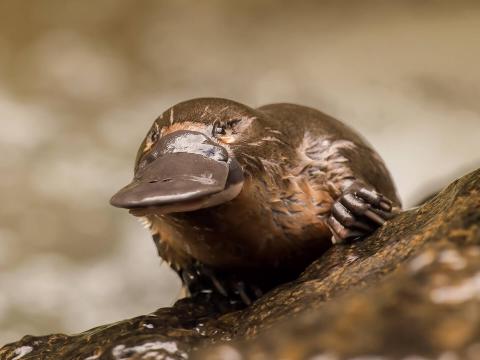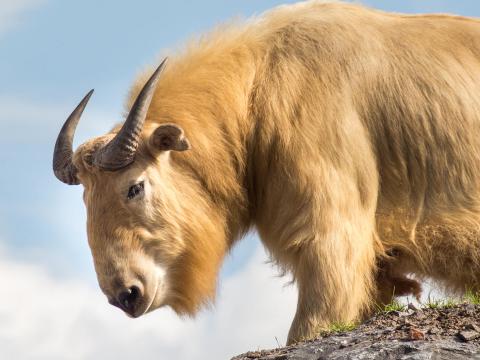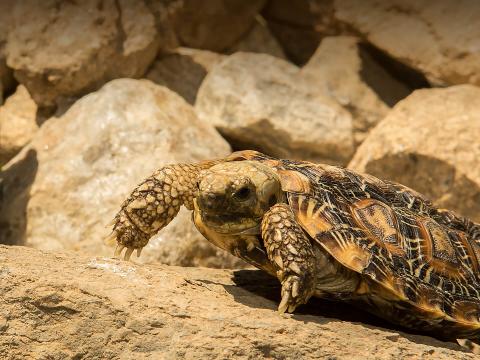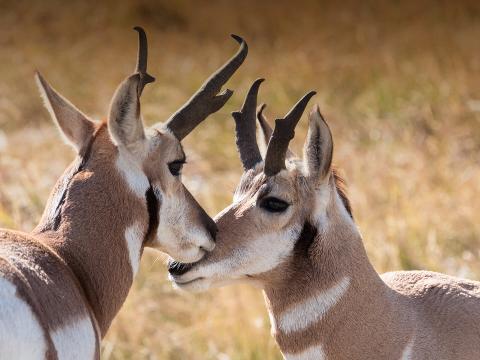Sun Bear
- CLASS: Mammalia (Mammals)
- ORDER: Carnivora
- FAMILY: Ursidae
- GENUS: Helarctos
- SPECIES: malayanus
- SUBSPECIES: euryspilus (Bornean sun bear), malayanus (Malayan sun bear)
ABOUT
Small but mighty: The sun bear is the smallest of the world's eight bear species, about half the size of the American black bear. Its common name comes from the white or yellowish crescent marking on its chest, which many people think looks like the rising or setting sun. Each bear’s crest is individual—like fingerprints.
The sun bear’s jaws provide a powerful bite force and are often used to tear into trees to get at the burrowing insects beneath the bark. They have a distinctive pigeon-toed walk, an adaptation to their arboreal lifestyle. Like other bears, sun bears have an incredible sense of smell, thought to be several thousand times better than that of humans.
HABITAT AND DIET
Tree, sweet tree: In the Malay language, the sun bear is called basindo nan tenggil, which means “he who likes to sit high.” It certainly lives up to that reputation! The sun bear likes to make its home in the branches of trees. Its small size, 4-inch-long (10 centimeters) claws, and large paws with hairless soles help the little bear move about with ease high up in trees.
Those branches also make a nice place to build a nest for resting or sunbathing during the day, although in areas undisturbed by humans, sun bears are more likely to rest on the ground. Their eyes are more forward-facing than those of longer-snouted bears like polar bears, which is another adaptation thought to aid in climbing.
The sun bear has all the tools necessary to protect itself. Those claws and canine teeth are handy weapons in a fight. If a predator were to latch on during a struggle, the sun bear can turn in its loose skin and bite its attacker. And even though the sun bear lives in a hot, humid climate, its short, sleek, dark-brown coat is unusually thick and dense to protect the bear against twigs, branches, falls, and heavy rain. What’s more, the sun bear can be a quick mover when it needs to be, outpacing more lumbering bears like giant pandas.
The omnivorous sun bear relies primarily on fruit and insects to meet its needs. Its front paws and long claws rip open trees in search of insects or sap. Other occasional food choices include small birds, fruit, honey, lizards, rodents, and soft parts of palm trees. Strong jaws and teeth even help this bear open coconuts!
The sun bear’s especially long tongue is perfectly suited for getting at honey and insects inside trees and other tight places. Its appetite for coconuts, oil palms, and other commercial crops has led to a lot of conflict between sun bears and humans. Sadly, this conflict is a significant conservation threat to the sun bear, as the little bears are often killed or confiscated for the pet trade.
At the San Diego Zoo, sun bears eat fruit, vegetables, and an omnivore pellet. They also receive bones to gnaw on twice a week and, for enrichment, an assortment of mealworms, crickets, and other tasty items!
FAMILY LIFE
Cub scouting: Sun bears don’t have a particular breeding season; in fact, adult female sun bears are the only type of bear known to cycle several times each year. Nests have been observed in leafy vegetation on the ground or in hollow logs. Cubs are born hairless and helpless, unable to hear or smell, and are completely dependent upon their mother for food, warmth, and protection. Mothers sometimes walk upright and carry their babies in their paws or mouth to move them from place to place.
Sun bear youngsters are able to run and play at about 4 to 5 months of age, and they are probably naturally weaned at about 18 months of age. They probably stay with their mother, however, for about two years as they learn the facts of life.
Sun bears vocalize using a variety of different sounds. Adult bears use a clucking noise, resembling the sound of a hen, which is a typical contact call signaling friendly intent. Aggressive sun bears can bark, growl, and roar, not unlike other bears. Cubs hum while nursing and squawk or cry when in need of their mother’s attention.
The degree to which sun bears use chemical communication has not been well documented. Sun bears do rub against rocks and trees, a behavior known from other bears to deposit hair and other scent samples that others can investigate. Sun bears do sniff the urine and feces of other sun bears and appear to get some chemical information from these “messages.” However, sun bears are not known to engage in anogenital scent marking like their distant relative, the giant panda.
CONSERVATION
Sun bears are vulnerable to extinction. It is unknown how many are left, since their secretive nature makes them hard to find, and few studies have focused on these bears. This lack of data currently prevents them from being listed as endangered; however, sun bear populations are believed to be dwindling rapidly, due mainly to habitat loss from farming and logging, poaching (both for meat and use in medicines), and even the pet trade. Their appetite for oil palm and other commercial crops has led to a lot of trouble between sun bears and humans, and sun bears are walking a survival tightrope.
The population of this rare bear is thought to have declined more than 30 percent in the last 30 years. Although it is illegal to kill sun bears, laws protecting them are rarely enforced.
San Diego Zoo Wildlife Alliance, through past participation in the Bornean Sun Bear Species Survival Plan and current collaborative efforts with zoos worldwide, is working hard to help these petite bears. We also partner with the Bornean Sun Bear Conservation Centre (BSBCC) in Sabah, Borneo. BSBCC serves as a rescue and rehabilitation facility for orphaned and injured sun bears.
We are excited about developing our partnership into a conservation work opportunity that will aid in the protection of the smallest bear on Earth and could lend insight into this bear’s biology. We know from our past work, for example, that sun bear mothers and panda mothers are very similar in their attentive maternal-care styles, and both pandas and sun bears differ from the less active hibernating bears like brown and black bears. What other similarities and differences between the many bears will we find?










